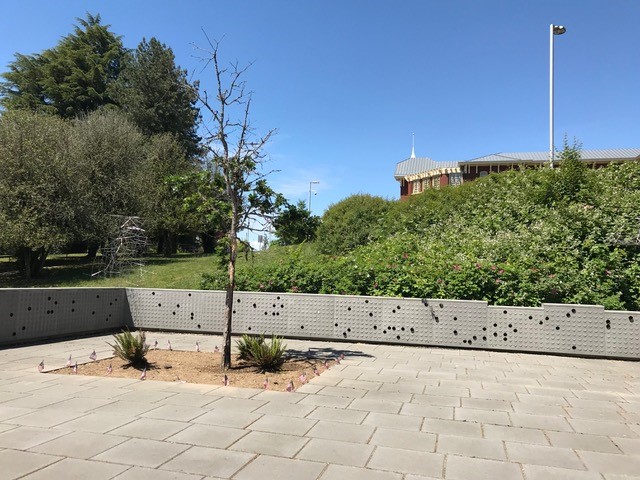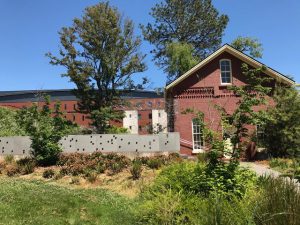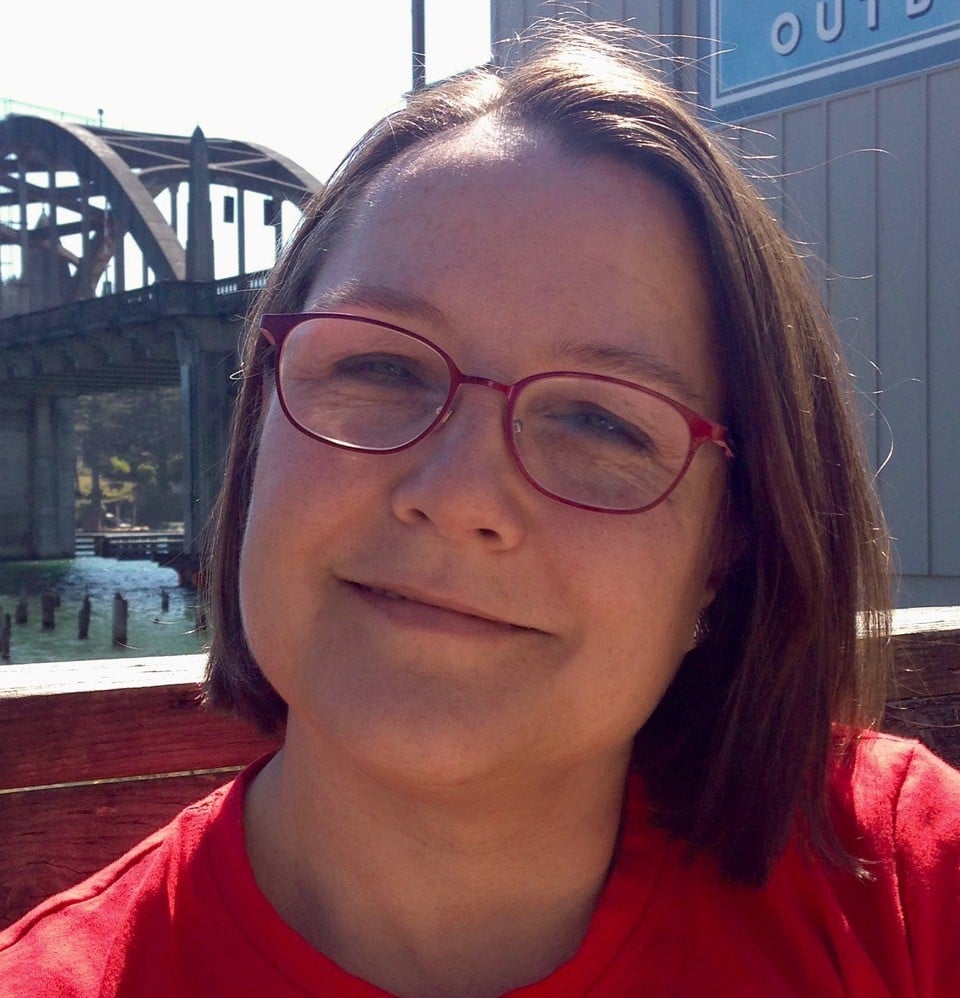 Empty copper tubes mark spots where ceramic containers of ashes have been removed to be reunited with families. The original Oregon State Insane Asylum building is visible in the background.
Empty copper tubes mark spots where ceramic containers of ashes have been removed to be reunited with families. The original Oregon State Insane Asylum building is visible in the background.
If you do family history long and broadly enough (searching out great-great-aunts and fifth cousins, as well as your direct ancestors), you’re sure to find them: family members whose census or burial records indicate that they were living in a state hospital or similar institution.
A couple of weeks ago, my husband and I visited the Oregon State Hospital’s museum … and also their memorial garden, which houses the unclaimed ashes of thousands of people who died at various state institutions. The ashes had been stored for about a decade in underground vaults, but after water seepage was discovered, the copper canisters were removed and consigned to shelves in a storage room. Then a group of legislators touring the hospital brought their existence to light in 2004, and that discovery helped spark change for the hospital’s residents, living and dead.
Even the mid-twentieth-century buildings (including the one where Ken Kesey’s One Flew Over the Cuckoo’s Nest was filmed in 1975) have been demolished...
The oldest part of the hospital, built in the late nineteenth century, now no longer houses residents but has been preserved for the museum and offices. Even the mid-twentieth-century buildings (including the one where Ken Kesey’s One Flew Over the Cuckoo’s Nest was filmed in 1975) have been demolished, and residents now live in all new facilities.
 The new Oregon State Hospital is visible behind the memorial courtyard. The Victorian shed at right houses the now-empty copper cremains containers, and its north wall has been removed to make the interior visible from the courtyard.
The new Oregon State Hospital is visible behind the memorial courtyard. The Victorian shed at right houses the now-empty copper cremains containers, and its north wall has been removed to make the interior visible from the courtyard.
But what to do with those thousands of unclaimed remains? Two things happened: A memorial was designed to respectfully house them and display the fascinating (now empty) copper canisters, and the legislature passed a bill allowing their names to be published so that family members might find them. Devoted volunteers then began researching their life histories and making the information available online. One by one, remains have been departing and going home.
Almost two years ago, the case of a Civil War veteran who had been interred in this memorial gained a degree of publicity … even notoriety. Pvt. Jewett Williams had been a member of the 20th Maine Volunteer Infantry, and saw Lee’s surrender at Appomattox Courthouse. Eventually he made his way to Oregon, where he died in 1922, three months after arriving with dementia at the state hospital.
 Over three thousand empty copper containers (some badly oxidized) are displayed in the memorial. Empty spots are left when corresponding containers are returned to families along with the actual ashes, now encased in porcelain vessels.
Over three thousand empty copper containers (some badly oxidized) are displayed in the memorial. Empty spots are left when corresponding containers are returned to families along with the actual ashes, now encased in porcelain vessels.
A Maine historian discovered his name and details online, and arrangements were made for his remains to be taken by Patriot Guard Riders across the country – with a stop in Appomattox – to Maine for interment at Togus National Cemetery. A local group of Civil War re-enactors were honored to take part in memorial services for Pvt. Williams as he set out on his journey … not least because they portray the 20th Maine Volunteer Infantry. He was truly a brother soldier!
Things got a little dicey by the time Pvt. Williams’s remains actually arrived in Maine; by that time distant cousins had learned about him and wanted to have his remains buried with his parents in his hometown of Hodgdon. Not all of the folks who’d arranged for the journey agreed, and there were some hard feelings.
I remembering hearing about all this on the genealogy podcast Extreme Genes, and it sounded very interesting, but not in a personal way. Then I discovered that the brother-in-law of my maternal grandfather’s aunt was enumerated in the 1900 census at the Oregon State Insane Asylum, as it was then called. I presume (but don’t know for certain) that his death four years later at the age of 33 occurred at the institution.
Wiley Hubbard was the youngest son of William Cannon Hubbard, a former Marion County Commissioner whose family settled in the Willamette Valley a decade before Oregon became a state in 1859. According to an 1893 city directory, he had been living with his family just a few blocks from my current home! If Wiley died at the state hospital and had been unclaimed by his family, he would have been buried in their cemetery … and no one knows what happened to those remains after they were disinterred in 1913.
Thankfully, Wiley was spared this fate, and lies buried in the family plot at Claggett Cemetery, north of Salem.
Share this:

About Pamela Athearn Filbert
Pamela Athearn Filbert was born in Berkeley, California, but considers herself a “native Oregonian born in exile,” since her maternal great-great-grandparents arrived via the Oregon Trail, and she herself moved to Oregon well before her second birthday. She met her husband (an actual native Oregonian whose parents lived two blocks from hers in Berkeley) in London, England. She holds a B.A. from the University of Oregon, and has worked as a newsletter and book editor in New York City and Salem, Oregon; she was most recently the college and career program coordinator at her local high school.View all posts by Pamela Athearn Filbert →